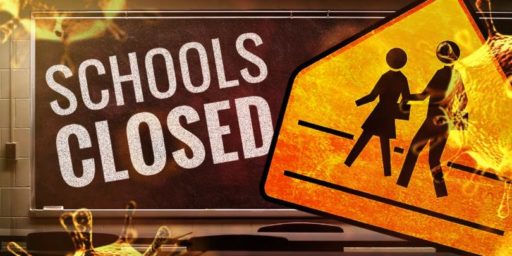‘No Child’ Left Behind Unreasonable
As the “No Child Left Behind” act is coming up for renewal, critics are arguing that it mandate that all students achieve grade level proficiency in math and reading by 2014 is unrealistic.
“There is a zero percent chance that we will ever reach a 100 percent target,” said Robert L. Linn, co-director of the National Center for Research on Evaluation, Standards and Student Testing at UCLA. “But because the title of the law is so rhetorically brilliant, politicians are afraid to change this completely unrealistic standard. They don’t want to be accused of leaving some children behind.”
[…]
Critics, including some teachers unions and many testing experts, view the law as a forced march toward an impossible education nirvana. They are lobbying Congress to reduce the 100 percent target and delay the 2014 deadline. They are also pushing for the elimination of sanctions — which can cost millions of dollars and result in school takeovers — that school systems face for failing to make yearly progress toward the goal.
But critics face an uphill challenge because of the rhetorical power of the argument for a universal proficiency target and a deadline. Anything less, advocates say, will hurt children, especially society’s most vulnerable: poor and minority students. “We need to stay the course,” U.S. Deputy Education Secretary Raymond Simon said. “The mission is doable, and we don’t need to back off that right now.”
[…]
“The idea of 100 percent is, in any legislation, not achievable,” said Sen. Edward M. Kennedy (D-Mass.), chairman of the Senate education committee. “There isn’t a member of Congress or a parent or a student that doesn’t understand that.”
I agree with Kennedy that, barring setting “grade level” standards that are meaningless, 100 percent is unattainable. Now, it seems perfectly reason to require demonstration of grade level proficiency for passage to the next grade or graduation at the student level; otherwise, why have grade levels or diplomas at all? But it is hardly reasonable to deem schools or school districts “failures” because some of the kids who happen to live there aren’t bright or hard working.
So, why set a goal that virtually nobody thinks can be met? Kevin Drum sees a diabolical plot:
Because the 100% goal isn’t just rhetorical. It comes with penalties. If you don’t meet the standard, you lose money, you’re officially deemed a “failing school,” and your students are eligible to transfer to other schools. And needless to say, by 2014 there won’t be any satisfactory public schools to send them to because 99% of them won’t have met the standard.
Followup bonus question: What incentive does anyone have to label 99% of America’s public schools as failures? That’s crazy, isn’t it?
Answer: Anyone who wants the public to believe that public schools are failures. This would primarily consist of conservatives who want to break teachers unions and evangelicals who want to build political momentum for private school vouchers. The whole point of NCLB for these people is to make sure that as many public schools as possible are officially deemed failures.
While I’m not an evangelical, I’d love to see a system with more choice, allowing parents to send their kids to any public or private school for which they could qualify. Still, the need for kids from the poorest families to be able to get the best possible education is almost universally recognized.
So, what are the alternatives?
Surely, not the status quo ante. The reason NCLB was such an easy sell was that we in fact had huge numbers of schools that Kennedy, Drum, and I would all agree were failures. Yet, like virtually any public institution, there was no penalty for failure. That’s what the teachers unions want to return to, because their concern is job security for their members, not educating children. Let’s delay the deadline — which was already one entire child-cycle of 12 years away when established — even more and let’s remove any penalties for failure.
So, presumably, the solution is something in between setting truly unattainable goals with draconian penalties for failure and having no goals and no penalties.
The problem, as the WaPo piece alludes to, is that any standard below 100 percent will have a disparate effect on schools in the poorest districts and those with the largest black and Hispanic populations. How low, then, can we go? Ninety percent? Eighty? Fifty?
There is such a thing as failure, most would agree. Defining it is incredibly difficult. The politically expedient thing is to simply set it at 100 percent, because nobody will fault you for the goal of leaving no child behind.
UPDATE: Matt Yglesias is also dubious of the secret plot of the NCLB sponsors, including Teddy Kennedy, to destroy the public education system. He correctly notes that there are plenty of other reasons to be skeptical of NCLB and invites readers to search the Cato archives for some. I did so and found this from Lawrence Uzzell:
The NCLB statute is a reform strategy at war with itself. It virtually guarantees massive evasion of its own intent, ordering state education agencies to do things that they mostly don’t want to do. Washington will be forced either to allow the states great leeway in how they implement NCLB or to make NCLB more detailed, prescriptive, and top-heavy. If Washington chooses the former, the statute might as well not exist; if the latter, federal policymakers will increasingly resemble Soviet central planners trying to improve economic performance by micromanaging decisions from Moscow. NCLB may end up giving us the worst possible scenario: unconstitutional consolidation of power in Washington over the schools, with that power being used to promote mediocrity rather than excellence.
It is too early to know for certain which scenario will prevail, but it is already clear that state and local education officials are skillfully protecting their interests in ways that undermine the intent of NCLB. Especially telling has been their widespread dishonest reporting in at least four areas: graduation rates, school violence, qualified teachers, and proficiency tests. As it becomes increasingly clear that the states can satisfy the requirements of NCLB by lowering their standards, there will likely be a “race to the bottom.”
Instead of using centralized decrees to turn mediocre institutions into excellent ones, as they have been trying but failing to do for the last several decades, the state and federal governments should be empowering individual families to “vote with their feet” by transferring to the schools of their own choice.
Now, ultimately, NCLB aims to do just that. Starting in 2014. For the worst of the worst schools. Like Uzzell, though, I’d prefer not to have to wait that long.






The main reason teachers are against No Child Left Behind is that it places the entire burden of education on the school system.
Research in cognition and education policy suggests that childrens’ development is more correlated with a supportive family and a higher household income than anything teachers necessarily do or fail to do.
That sounds like something I read years ago in The Bell Curve.
Research in cognition and education policy suggests that childrens’ development is more correlated with a supportive family and a higher household income than anything teachers necessarily do or fail to do.
Sure. And I’m all in favor of higher household incomes and supportive families. How, though, do we make those, especially the latter, happen via the public policy process?
Tell the teachers that during the next union negotiation
Fully and enthusiastically conceded.
It does not follow that government should be the producer of that education. Being the regulator and financer are quite enough.
William Julius Wilson has some interesting ideas on this, which I’m sure you would oppose. But they boil down to more inner-city job creation at a decent wage.
The main problem with NCLB is that it is based on the presumption that schools are isolated from the rest of society–which is fundamentally problematic.
The main reason teachers are against No Child Left Behind is that it places the entire burden of education on the school system.
Partially, it isn’t that the burden is on the public school system (which after all does have a monopoly so it has assumed that burden to some degree, and wants to be the sole provider of it).
They don’t like the accountability aspect. The testing the kids take also keeps a record of which teachers failing students have. So each student a teacher opts to pass on to the next grade has their name attached to that students score-that is a scary prospect.
I think the one thing NCLB has done at least in our school is made the school less reluctant to retain kids, if they can’t meet the outcomes, they are more likely to see retention.
I do think 100% of all kids at grade level is an unrealistic goal. I would much rather see tests indicate the amount of proggress a child is making than comparing one years grade to the kids from the next years grade-they may not be comparable.
I have no problems with testing, and I have no problems with demanding that schools meet a specific standard, but I do think the standard should be realistic.
In the end I suspect one reason 100% was used, was to keep schools from deeming a certainn number of students as throwaways. I can easily see, if the goal was 90%, the schools not working to hard with the lowest 10% and focusing on the other 90%.
Research in cognition and education policy suggests that childrens’ development is more correlated with a supportive family and a higher household income than anything teachers necessarily do or fail to do.
I would say that this is pretty much a true statement. I don’t think anyone in education needs to see this kind of research to know this.
NCLB though does have various grants that are designed to bring parents into the school and get them involved. Our school participates in the reading first grant. The school is required to have family literacy night every other month. They also have various incentives, and other things to try to get parents involved. It works nominally well, but at least they are trying.
So, NCLB does try to address this, but there is only so much a school can do to get a parent involved, and in the end crappy parents doesn’t excuse the school from doing its job, which is to educate children.
My children go to a school district in which seven of the nine schools (6 elementary, 2 Jr. high and one high school) are rated exemplary. To get the exemplary rating, they have to get a 90% pass rate for the schools students overall and all subgroups (including racial and economic) in Reading, writing, social studies, math and science (aka the core curriculum). Plus that have to have no more than 0.2% dropout of all students including by sub-group. The high school also has to graduate 95% of the students within 4 years (graduating requires passing the standardized tests).
This is an obviously achievable goal. As a district, the overall scores were 98% reading, 99% writing, 99% social studies, 95% math and 94% science. One of the schools that didn’t make exemplary was because the special ed kids only had a 77% pass rate.
It very well may be that when it comes time to have the 100% rating requirement, that they shift from a government sourced funding to parent sourced funding in the form of tuition credits. That would let parents decide what they find acceptable.